Many anglers across North America would argue that saugers are one of the most underrated species ever. Not only do they taste amazing, but they are also a delight to catch. Saugers are just one of the over 120 species of fish found in the Mississippi River, but without a doubt, they are a unique species. They are freshwater perciform fish and are closely related to walleyes. Discover the largest sauger ever caught in the Mississippi River below.

Saugers in the Mississippi
Saugers (Sander canadensis) are classified under the Percidae fish family, which is filed under the Perciformes, the largest vertebrate order of ray-finned fish. Perciformes first appeared in the Late Cretaceous period. The Late Cretaceous period occurred about 100.5 million years ago to 66 million years ago, making perciforms close in age to the 70-million-year-old Mississippi River.
Like all Percidae, saugers have fins. They have a pair of dorsal fins, one spiny and the other soft-rayed. They also have ctenoid scales, which are jagged or teeth-like at the edges, making them rough to touch. Their fusiform body structure allows them to swim into strong and fast currents, a necessity considering their migratory habits.
How Large Do Saugers Get?

Adult saugers average 11 to 14 ounces and measure 10 to 18 inches long.
©Kara Grubis/Shutterstock.com
Saugers aren’t usually large fish. Adult saugers average 11 to 14 ounces (0.69 to 0.89 pounds) and measure 10 to 18 inches (254 to 457.2 mm) long. Saugers, like walleyes, are of the Sander genus and have a distinct resemblance to the unrelated Esocidae (pike) family, which gives them the “pike-perch” nickname.
Saugers, however, are believed to have speciated into their modern form about 7.3 million years ago, making them much younger than the Mississippi and some other rivers in which they are now found. Saugers were first officially described and thus recorded into history in 1834 by two British naturalists and explorers under the name Lucioperca Canadensis. They were able to do this based on the work of Georges Cuvier, a French naturalist, and anatomist.
What is the Largest Sauger Ever Caught In The Mississippi?
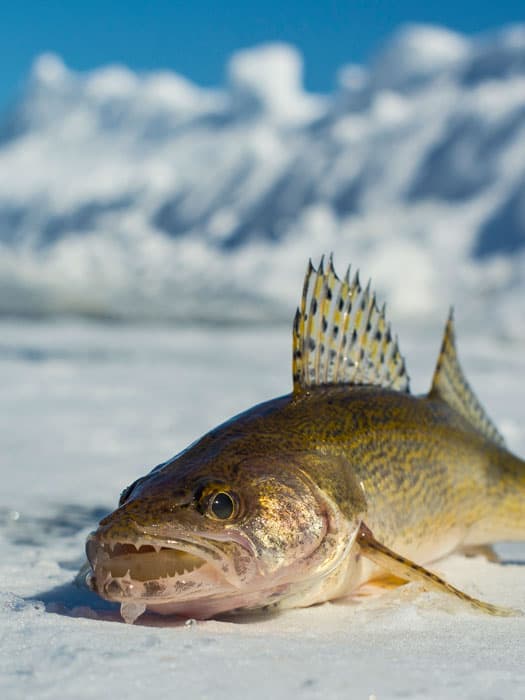
The largest sauger ever caught weighed 6 pounds and 6.7 ounces.
©Steve Oehlenschlager/Shutterstock.com
Since saugers are quite a favorite for anglers all over the US, it’s no shocker that many states have records for the largest sauger caught. The largest sauger ever caught in the Mississippi River was in Wisconsin’s Pierce County. According to the Wisconsin Department of Natural Resources, it weighed 6 pounds, 6.7 ounces.
A close record was set in Minnesota’s Goodhue County. The sauger weighed 6 pounds, 2 ounces, and was caught in 1988 on the 23rd of May. Illinois’ record sauger catch came closely behind, weighing 5 pounds and 12.5 ounces. The record for the state of Kansas was a 4-pound and 13 ounces catch and Mississippi state followed closely behind with a record of 2 pounds and 8 ounces.
However, some of the most interesting records can be found in North Dakota. North Dakota holds the world record for large saugers, a record set by Mike Fischer, who reeled in an 8 pounds and 12 ounces catch on the 6th of October, 1971.
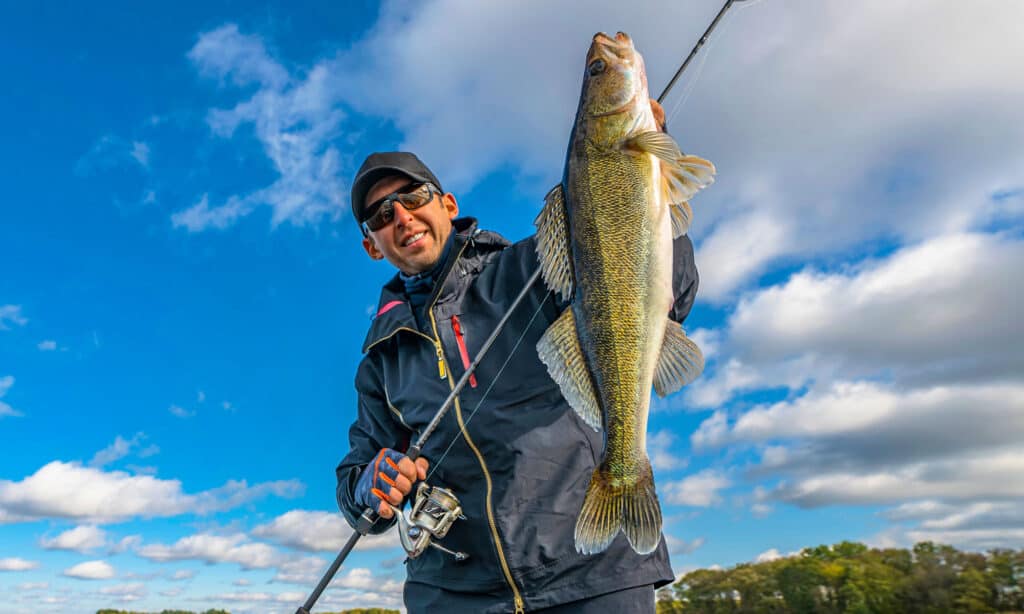
Walleyes are much larger than saugers.
©FedBul/Shutterstock.com
How To Differentiate Saugers From Walleyes
Since saugers and walleyes are in the same fish family, they are often confused or mistaken for each other. However, saugers have colors with darker hues. They also have a spotted dorsal fin which walleyes do not have. Walleyes, on the other hand, have a white splotch on their caudal fins and have smoother skin over their gills. In addition, they are generally larger than saugers.
Saugers and walleyes are known to interbreed and give birth to a sauger-walleye hybrid known as a saugeye. Saugeye hybrids are usually larger than saugers. The largest saugeye caught in Mississippi state weighed 4 pounds and 11 ounces. It was a specimen caught in the Bay Springs Lake. In Minnesota, the largest saugeye was caught in the same lake where its largest sauger was caught; Goodhue County. The saugeye weighed 9 pounds and 13 ounces.
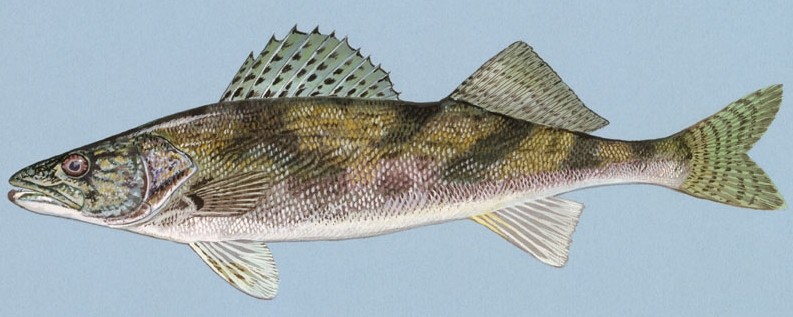
Walleyes and sauger interbreed to make saugeyes.
©Duane Raver / public domain – License
However, according to Outdoorlife, the largest saugeye on record was caught in North Dakota by Dave Fairman. It weighed 12 pounds and was confirmed by the North Dakota Game and Fish Department.
Impressive Facts About Saugers
- Saugers mostly inhabit large rivers at least 2 feet (0.6 m) deep.
- Sauger eggs hatch in 1 to 4 weeks, depending on the temperature of the water. They grow fast and are considered adults when they measure 9.8 inches (250–300 mm) long. This takes anywhere from 2 to 4 years.
- Sauger fish live for an average of 7 to 8 years.
- Saugers mostly feed on fish but also eat crustaceans and insects.
What is the Best Bait to Catch Sauger Fish?
According to the Illinois Department of Natural Resources, the best bait to catch saugers is a large jig designed to go deep enough to be dragged along the river’s bottom. This is because saugers are known to live near the bottom most of the time. Perhaps this tip helped the Illinoisan angler who caught the state record saugeye of 9 pounds, 11 ounces in 2001.
3 Large and Unique Fish Species Found in the Mississippi
The Mississippi is home to many large and weird-looking fish that make saugers and walleyes look tame. Here are 3 unique fish of the Mississippi River.
Paddlefish
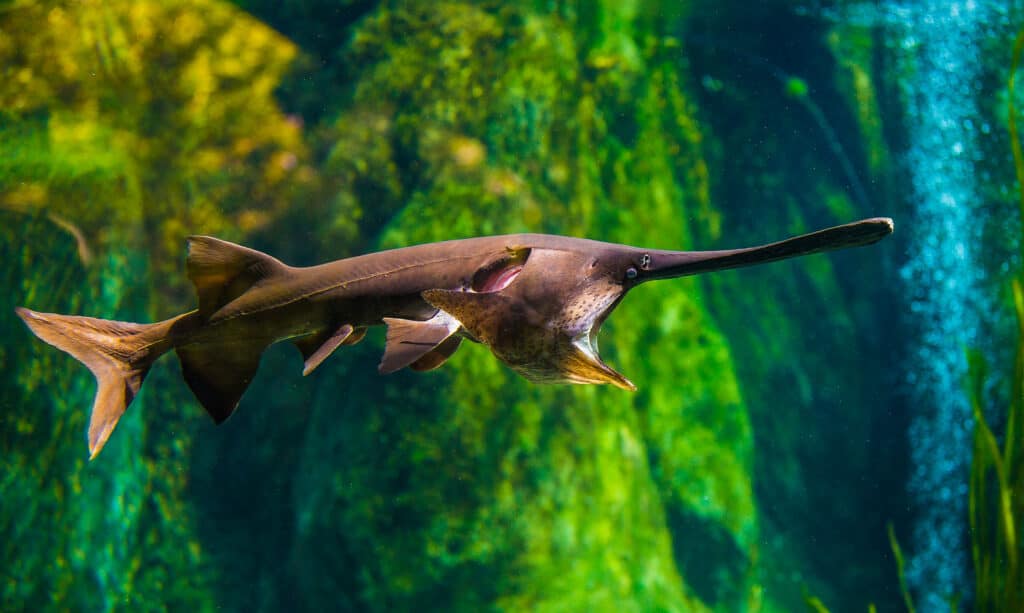
Paddlefishes grow up to 5 feet and weigh more than 60 pounds.
©Saran Jantraurai/Shutterstock.com
Paddlefish are known as primitive fish because they have only evolved slightly from the earliest fossil records. They grow up to 5 feet long and weigh more than 60 pounds. However, what makes them stand out most are their paddle-like snouts. They are called rostrums and have electroreceptors that are used to detect prey. They have gray or green smooth scales and feed on plankton by filter-feeding. Paddlefish eggs are used to make caviar, making the demand for these fishes high.
Gulf Sturgeons

Gulf sturgeons grow as long as 8 feet and weigh more than 200 pounds!
©Chase D’animulls/Shutterstock.com
Gulf sturgeons are large fishes. They have large snouts and five rows of scutes, bony plates spread across their bodies. They are known to grow as long as 8 feet and weigh more than 200 pounds! Even more shockingly, they can jump up to 9 feet in the air.
Alligator Gar
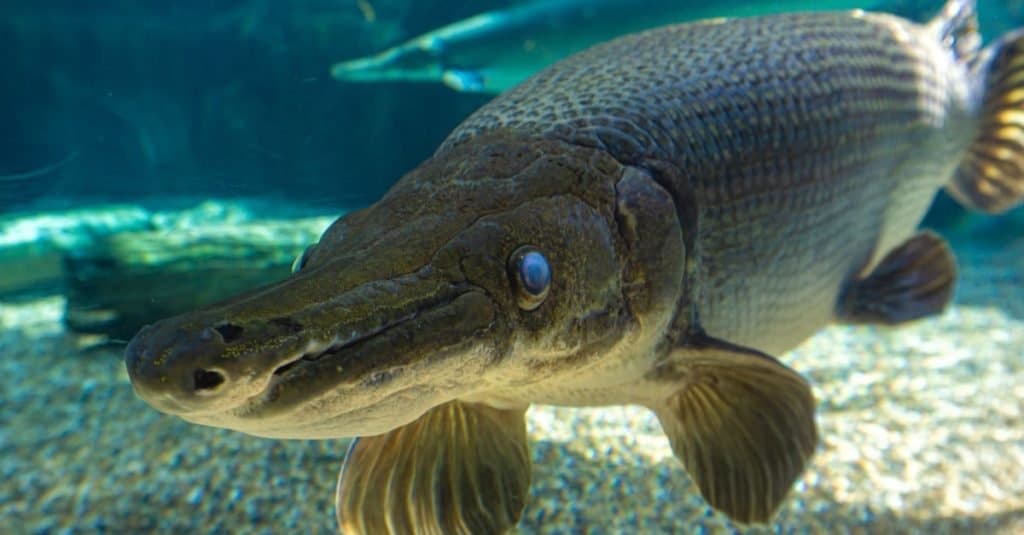
Alligator
gars measure 6 feet and weigh over 100 pounds on average.
©TKBackyard/Shutterstock.com
As their name implies, alligator gars are alligator lookalikes. They have torpedo-shaped bodies and measure 6 feet long on average. Alligator gars weigh over 100 pounds and are also one of the oldest fishes in the Mississippi. They have teeth-like scales, which Native Americans used as arrowheads.
The photo featured at the top of this post is © iStock.com/KaraGrubis
Thank you for reading! Have some feedback for us? Contact the AZ Animals editorial team.






